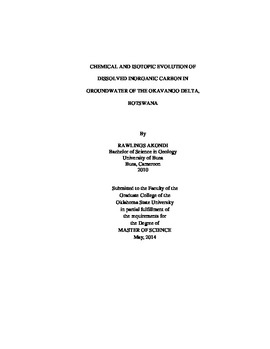| dc.contributor.advisor | Atekwana, Eliot Anong | |
| dc.contributor.author | Akondi Nkerh, Rawlings | |
| dc.date.accessioned | 2015-06-17T20:04:26Z | |
| dc.date.available | 2015-06-17T20:04:26Z | |
| dc.date.issued | 2014-05-01 | |
| dc.identifier.uri | https://hdl.handle.net/11244/14684 | |
| dc.description.abstract | This paper reports the results of a study of the origin and the chemical and isotopic evolution of dissolved inorganic carbon (DIC) in groundwater in the Okavango Delta in semi-arid Botswana. The Okavango Delta is one of the few examples of large river systems where carbon is cycled entirely in the terrestrial system and we hypothesized a river origin for carbon in groundwater. We measured DIC, major ions and the stable carbon isotopes of DIC (δ13CDIC), hydrogen (δD) and oxygen (δ18O) in groundwater. We used our results along with published chemical and isotopic results for groundwater and surface water to assess the origin and evolution of DIC in groundwater in the Okavango Delta. The DIC concentrations increase progressively from surface water to shallow groundwater (<5 m) to deep groundwater (≥50 m) and the DIC concentrations are two to ten times higher in groundwater than in the Okavango River. The δ13CDIC of the shallow and deep groundwater were lighter than for surface water, suggesting that the carbon if from River water recharge was modified by input of DIC with lighter carbon isotope. The δD and δ18O for surface waters are enriched by evaporation, and when compared to groundwater, the isotopes distinguish groundwater that is recharged by the evapo-concentrated river water and directly by rain. Despite the differential recharge sources (rain vs. river) with marked isotopic differences, the chemical evolution of the groundwater within the Okavango Delta and surrounding is indistinguishable and is not chemically related to modern day river water and shallow groundwater. We suggest open system carbonate evolution for river and island groundwater and closed system carbonate evolution for deep groundwater. The lack of genetic connection for the chemical evolution between modern day surface water and the deep groundwater suggest that the deep groundwater may not be recharged by present day Okavango River. We conclude that DIC concentrations in groundwater of the Okavango Delta originates from subsurface production of DIC, and is mostly old DIC stored in the groundwater system for long periods of time (>0.8 ka). | |
| dc.format | application/pdf | |
| dc.language | en_US | |
| dc.publisher | Oklahoma State University | |
| dc.rights | Copyright is held by the author who has granted the Oklahoma State University Library the non-exclusive right to share this material in its institutional repository. Contact Digital Library Services at lib-dls@okstate.edu or 405-744-9161 for the permission policy on the use, reproduction or distribution of this material. | |
| dc.title | Chemical and Isotopic Evolution of Dissolved Inorganic Carbon in Groundwater of the Okavango Delta, Botswana | |
| dc.type | text | |
| dc.contributor.committeeMember | Quan, Tracy M. | |
| dc.contributor.committeeMember | Donoghue, Joseph F. | |
| osu.filename | AkondiNkerh_okstate_0664M_13353.pdf | |
| osu.accesstype | Open Access | |
| dc.description.department | Geology | |
| dc.type.genre | Thesis | |
| dc.subject.keywords | carbon cycling | |
| dc.subject.keywords | dissolved inorganic carbon | |
| dc.subject.keywords | groundwater evolution | |
| dc.subject.keywords | okavango delta | |
| dc.subject.keywords | stable isotopes | |
